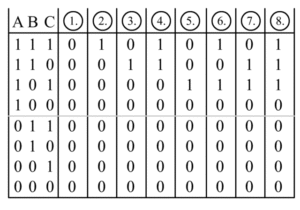9.1 Testing Validity for Complex Arguments
Nothing in this module should be new, but you will have to apply what you have learned to more difficult problems.
Most of the valid arguments we encounter in ordinary language rely on a hybrid of propositional and categorical rules. Most of the invalid arguments we encounter in ordinary language seem intuitively invalid, but it takes work to prove to those who make them that they are invalid.
The goal of this module is to give you a method for proving that an argument which seems valid is valid, or proving that an argument which seems invalid is not valid, at least within the rules of propositional or categorical logic.
Table of Contents
- 9.1 Testing Validity for Complex Arguments
9.1.1 Applications of Valid Arguments

While sound, the rules of logic we have studied in this class are incomplete.
Image Credit: Paul Mannix under license CC BY 2.0 (https://creativecommons.org/licenses/by/2.0/) via Flickr
Review
We started this course by introducing the notion of a valid argument, an argument where there is no possibility of a false conclusion provided that the premises are true. At first, we explored this notion through informal logic, and the many common fallacies which lead people into unsound reasoning. In order to make validity more methodical, we then developed it into a formal notion. In propositional logic, validity was modeled using truth tables: a valid argument is one where there is no row on a truth table where all of the premises of the argument are true and yet the conclusion of the argument is false. In categorical logic, validity was modeled using Venn Diagrams: a valid argument is one where the Venn Diagram created for the premises makes it so that the conclusion must be true also. We then proved the validity of a number of rules of inference, where any inference which follows the rules is guaranteed to be valid.
Applications of Formal Logic
Now we turn in the course to applying what we have learned in order to test whether arguments are valid and create valid arguments. Nothing in this module should be new. It will be more challenging, however, because you will have to apply many of the techniques you have learned in previous modules in order to complete the tasks in this module.
By the end of this module, you should be able to evaluate the validity of an argument. One way to evaluate validity is informal or intuitive validity: whether it seems, intuitively, that there could be a possible world where the premises are true and the conclusion is false. The more you study formal logic, the more accurate and better refined your intuitions about validity will become, and the less you will need to rely on formal logic. For this module, however, we’re going to be using formal methods: we’ll try to test whether an argument is valid given the rules of propositional logic or categorical logic.
After we’ve determined whether an argument is valid or invalid, we will then begin thinking through how to determine whether or not an argument is sound or unsound. Recall that an argument is sound if it is valid and all of its premises are true. So, to determine whether or not an argument is sound, we will need to understand how to determine whether or not a premise is in fact true in our world. This will take us in later modules into the discussion of evidence and probability.
Soundness and Incompleteness
The systems of logic we have developed for propositional logic and categorical logic are sound but not complete with respect to the set of logically valid inferences. It is “sound”, because every inference made with one of our rules is a logically valid inference. It is not “complete”, however, because there are some inferences which are logically valid, but which we can’t prove valid using the tools of propositional and categorical logic. For instance, this argument is logically valid:
- The painting is red all over.
- The painting is not blue all over. (1)
This argument is also logically valid:
- It is morally permissible to protest the government’s actions.
- It is not morally obligatory to not protest the government’s actions. (1)
None of our existing rules or methods can prove that these arguments are valid. Other systems of logic, such as deontic logic, would be needed to show why these inferences are valid. Instead, using only the tools we have, we would have to add a premise to make them valid:
- The painting is red all over.
- Everything which is red all over is not blue all over.
- The painting is not blue all over (1, 2 UI)
or:
- It is morally permissible to protest the government’s actions.
- If it is morally permissible to protest the government’s actions, then it is not morally obligatory to not protest the government’s actions.
- It is not morally obligatory to not protest the government’s actions (1, 2 MP)
Don’t be surprised as we go through this module if you run into arguments which seem like they should be valid, but where it is necessary to add a premise in order to use one of our rules to prove them to be valid.
9.1.2 Recognizing Valid Arguments

Experience lets a Doctor intuit a diagnosis, just as students learn to intuit validity.
Strategies to Test Validity
Suppose you are given an argument and asked to determine whether or not it is valid:
ARGUMENT A
1. Every rabbit has fur.
2. Some rabbits eat carrots.
C. Some things which eat carrots have fur.
or
ARGUMENT B
1. Either Amos accepts the insult, or he gets upset.
2. Amos gets upset.
C. Amos doesn’t accept the insult.
or
ARGUMENT C
1. All winners are loved, but all losers are hated if they aren’t tall.
2. Jeff is a loser and Jeff is not tall.
C. Jeff is hated.
Where do you begin?
Step 1: Propositional, Categorical, or Both?
The first step is to determine whether proving the inference valid would require propositional logic, categorical logic, or a hybrid of both. To do this, we look at the logical connectives. Argument A above clearly requires categorical logic, because it uses the logical connectives “Every” and “Some”. Argument B clearly requires propositional logic, because it uses the logical connective “or”. Argument C requires a hybrid of both: the word “All” appears in line 1, indicating that Categorical logic is needed, but the words “if” and “and” also appear, indicating that propositional logic is needed.
Step 2: Intuitively Valid or Invalid?
The next step is to think about the argument intuitively. Does it seem invalid to you, or seem valid? How it seems is not a guarantee that it is. It will, however, guide you to the most efficient strategy to proving the argument valid or invalid. If you think about the arguments above, Argument A and Argument C ought to seem intuitively valid to you, but argument B might or might not seem valid to you.
Step 3a: If it seems Valid, prove it with the rules
If an argument seems intuitively valid, then try to use the rules of inference we have in order to prove that the conclusion follows through only applying existing rules of inference. This might mean adding steps to the argument, or intermediate inferences. Provided that all these steps are derived from the premises using valid rules of inference, it will still prove the argument is valid. Let’s try this with
Argument A:
Let
M = Rabbits
P = Things with Fur
S = Carrot-Eaters
1. All M are P
2. Some M are S
3. Some S are P (1, 2 CS)
The inference above meets the rules for a valid categorical syllogism. The mood of the syllogism is AII. The figure of the syllogism is 3. Categorical syllogisms of mood and figure AII-3 are valid (“Datisi”) syllogisms. So, this is a valid use of Categorical Syllogism.
3b: If it doesn’t seem Valid, use a Truth Table or Venn Diagram
If on the other hand an argument doesn’t seem valid — it either seems invalid or seems questionable — then the most efficient way to prove it is invalid is to use the tools of truth tables (if it is propositional) and venn diagrams (if it is categorical). The first step, of course, is symbolizing the argument to identify its abstract form. Let’s symbolize argument B, since that seems questionable:
1. Either Amos accepts the insult, or he gets upset.
2. Amos gets upset.
C. Amos doesn’t accept the insult.
Let:
A = Amos accepts the insult
U = Amos gets upset
1. A v U
2. U
C. ~A
Here is the truth table:
| A | U | 1. A v U | 2. U | C. ~A |
| T | T | T | T | F |
| T | F | T | F | F |
| F | T | T | T | T |
| F | F | F | F | T |
The only rows on which both premises are true are row 1 and row 3. A truth table tells us that an argument is valid if, on every row where all of the premises are true, the conclusion is true also. A truth table tells us that an argument is not valid given the rules of propositional logic (it isn’t truth functionally valid) if there is some row where all of the premises are true, but the conclusion is false. In this case, row 1 is a row where the premises are all true, but the conclusion is false. So, row one generates a counterexample: it might be that both A and U are true, that Amos accepts the insult but still gets upset. So, the argument is not truth-functionally valid. Now, it might be that there is some deeper logic of insults and emotions on which accepting an insult and getting upset are incompatible. So, we haven’t proven that the argument isn’t logically valid. We have only proven that it isn’t truth-functionally valid given propositional logic.
4. How to Handle Hybrid Arguments
Now, let’s try Argument C, a hybrid argument that involves both propositional and categorical connectives.
1. All winners are loved, but all losers are hated if they aren’t tall.
2. Jeff is a loser and Jeff is not tall.
C. Jeff is hated.
To deal with an argument like this, we will need to switch back and forth between applying propositional and categorical connectives. First, we can apply some basic propositional rules to break up the argument:
1. All winners are loved, but all losers are hated if they aren’t tall.
2. Jeff is a loser and Jeff is not tall.
3. Jeff is not tall (2, &E)
4. All winners are loved (1 &E)
5. All losers are hated if they aren’t tall (1 &E)
6. Jeff is a loser (2 &E)
Now, line 5 and 6 we recognize has this form:
S = Jeff
P = hated if they aren’t tall
M = losers
4*. All M are P
5*. S is M
This is of the first form, and AII-1 is a valid form of argument (“Darii”). So, we can derive:
7*. S is P (4*, 5*, CS)
That is:
7. Jeff is hated if they aren’t tall. (4, 5 CS)
Fixing the grammar, we get:
7. Jeff is hated if he isn’t tall (4, 5 CS)
Let’s reiterate line 3:
8. Jeff is not tall (3, Reit.)
Intuitively, the conclusion should follow from lines 7 and 8. We can symbolize to see how it might work:
Let:
H = Jeff is hated
T = Jeff is tall
Symbolized:
7. ~T => H
8. ~T
So, using modus ponens, we get:
C. H (7, 8 MP)
which is:
C. Jeff is hated.
9.1.3 Applied Truth Tables

A truth table, using binary ‘0’ for F and ‘1’ for T.
9.1.4 Applied Venn Diagrams

Venn Diagrams apply to all different kinds of Categorical Syllogisms.
Submodule 9.1 Quiz
Licenses and Attributions
Key Sources:
- Watson, Jeffrey (2019). Introduction to Logic. Licensed under: (CC BY-SA).
Next Page: 9.2 Proving Validity for Complex Arguments
